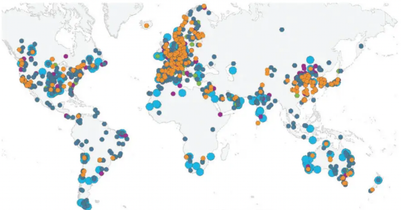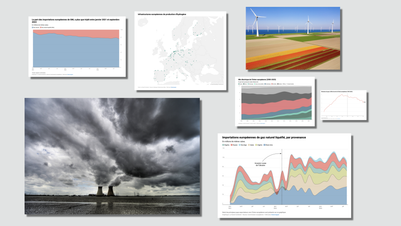working-paper
December 1, 2022
Report: Incentivising investment in European renewable hydrogen production
Hy24 and FiveT Hydrogen partnered with Shearman & Sterling to release a report framing several propositions for state revenue support for renewable hydrogen production in the European Union.

Report: Incentivising investment in European renewable hydrogen production
Hy24 and FiveT Hydrogen partnered with Shearman & Sterling to release a report framing several propositions for state revenue support for renewable hydrogen production in the European Union. While referring to available examples as well as the requirements of equity investors, and external debt financiers, the paper can be used as a manual to guide policy makers through the design choices they need to make when considering supporting renewable hydrogen production in their countries.
Read the executive summary below.
Framing the Issue
The European Commission has made clear that renewable hydrogen is necessary to meet the decarbonisation targets enshrined in Europe’s Climate Law (1). In 2021 the Fit for 55 package set out binding renewable hydrogen (RH2) usage targets and quotas which will apply from 2030 to enable the European economy to achieve these decarbonisation goals. In 2022, REPowerEU (2) the European strategy for reducing dependence on Russian fossil fuels, set even more aggressive targets, including RH2 production within Europe of 10 million tonnes / year (plus the same quantity in imports).
However, the high cost of RH2, whether produced in Europe or imported, threatens achievement of these objectives. For consumers, RH2 is not sufficiently competitive relative to the non-renewable energy or production processes it needs to replace, because:
- These do not incur a sufficiently high cost for associated greenhouse gas emissions;
- Renewable hydrogen production costs are high and will remain so until the supply chain is scaled-up and the resulting technology improvements materialise;
- Potential RH2 offtakers are delaying up-take decisions with the expectation that the price of RH2 will decrease (although whether this will in fact occur is debatable given significant supply chain bottlenecks and increasing capital financing costs facing the renewable energy industry in general), a decision which, collectively prevents the industry from achieving early ramp-up and benefiting from economies of scale; and
- there is insufficient supply to motivate the midstream and downstream infrastructure and other supply chain investments necessary to incentivise and implement large-scale offtake.
Until RH2 becomes cost-competitive, demand will continue to be shaped by policy rather than market forces. This will likely be the case throughout the 2020s and into the 2030s. As with any commercial activity, capital for RH2 production projects in Europe will not be available at sufficient scale or on commercially acceptable terms until there is certainty that revenues from RH2 sales will cover investment,
financing and production costs and provide a reasonable return for investors. Until then, investment will generally be limited to pilot projects, other small projects, and projects producing solely for captive or local consumption. The roll-out of key infrastructure and other necessary investments will be delayed in turn as investment in infrastructure will not achieve scale until supply has ramped-up concurrently. This creates a cycle of underinvestment where a lack of sustained demand for RH2, prevents investments in production and distribution infrastructure, which (in turn) further prevents demand from materialising.
These facts are acknowledged by the EU in its recently adopted Climate, Environment and Energy Aid Guidelines (CEEAG) (3). The CEEAG recognises that the Fit for 55 targets and quotas alone may not generate investment in RH2 production at the scale or speed required during the 2020s to facilitate meeting the 2030 requirements and State aid will therefore be required.
European countries are increasingly falling behind other economies, such as the US, Canada, North-East Asian and Middle Eastern states, in producing the policy and investment conditions necessary to meet RH2 targets. Capital is therefore mobilising to produce RH2 abroad, putting Europe at risk of being permanently and structurally dependent on imports of RH2, increasing both cost and supply risks whilst missing the opportunity to create European jobs, technology centres, manufacturing hubs and climate leadership.
The Proposed Solution
This paper proposes that Member States should establish aid schemes that would direct aid through competitive auctions. To be effective in scaling-up supply of RH2, the intervention by EU Member States (MSs) (or other states outside the EU) needs to be simple, limited and target the revenue uncertainty facing RH2 producers (that is, the combination of uncertainty in demand for and price of RH2), which is stifling investment. It should be designed to comply with the requirements of the CEEAG relating to aid to support renewable energy projects.
This paper analyses the issues to be considered by policy makers when designing RH2 production support schemes to achieve this objective. In doing so, it refers to available examples as well as the requirements of equity investors in, and external debt financiers of, RH2 production projects.
Notably, the CEEAG permits support in the form of guaranteed remuneration structures to limit exposure to negative scenarios for private investors where there is significant uncertainty concerning future market developments (and therefore revenues). This explicitly includes State aid for the production of RH2.
A support scheme of this kind would allow projects to raise equity and debt finance based on a more predictable revenue stream, facilitating larger scale projects and reducing the cost of capital and therefore the production cost of RH2. Today, a number of MSs are in the course of designing and pioneering aid schemes for the production of RH2, with different characteristics, each exhibiting pros and cons relative to the objectives they pursue and their effectiveness in addressing the risks for investors described in this paper. These include RH2 aid schemes in the Netherlands, Denmark, France, the United Kingdom, Germany and the USA. The key aspects of these support models are further considered in Section 3 of this paper.
Competitive auctions are the dominant approach in the CEEAG (and the approach adopted in the United Kingdom’s Low-Carbon Hydrogen Business Model) to ensure aid remains proportionate, avoids excessive distortion of competition, is kept to the minimum necessary and incentivises projects to produce RH2 at the cheapest possible cost. Such an approach will also encourage innovative project development, technology improvements and efficiency in financing, construction and operations, and ensure the best possible value for taxpayers.
Supply-side support to catalyse investment in RH2 production (as proposed in this paper) is by no means the only option available to states seeking to develop their RH2 economy. Other approaches include directing state support to, and thereby incentivising investment in, the mid-stream (i.e. the infrastructure required for RH2 transportation and use, including pipelines and RH2 re-fuelling stations) and/or the demand-side (one example of which could be through addressing the costs associated with technology or fuel switching for potential industrial users of RH2).
Different states around the world are likely to favour intervention in different parts of the RH2 supply chain. Ultimately, though, a range of approaches is likely to be required with different interventions in the supply-side, mid-stream infrastructure and the demand-side, each of which would need to be structured independently with regard to the market dynamics of that particular part of the supply chain. However, these other potential interventions fall outside of the scope of this paper.
This paper focuses on supply-side support from states to incentivise investment in RH2 production. However, this should not be taken as suggesting that interventions in other parts of the supply chain would not be effective, or indeed preferable, for particular states globally depending on their priorities and political agendas. A supply-side intervention in Europe is aligned with the industrial policy priorities of many European states in relation to the RH2 market (in terms of job creation, developing technology centres and stimulating indigenous sources of supply) as well as their experience with similar supply- side support schemes in other technologies (and therefore their willingness to adopt similar schemes).
“Incentivising investment in European renewable hydrogen production – A framework for state revenue support” report is co-authored by Nicolas Brahy, Alexandru Floristean with the support of Ella Carmi and Mathilde Morin, and Shearman and Sterling’s James Webber, Dan Feldman and Frederick Lazell.
(1) Regulation (EU) 2021/1119 of the European Parliament and of the Council of 30 June 2021 establishing the framework for achieving climate neutrality and amending Regulations (EC) No 401/2009 and (EU) 2018/1999
(2) REPowerEU: Joint European Action for more affordable, secure and sustainable energy COM(2022) 108 final
(3) COMMUNICATION FROM THE COMMISSION Guidelines on State aid for climate, environmental protection and energy 2022 (2022/C 80/01)

Innovating to finance the hydrogen economy
On the road to a more sustainable economy, we need more investment in sustainable assets. These investments must not only be supported by appropriate regulatory frameworks, but also encouraged and facilitated by financial mechanisms.
More about

Energy Europe – From integration to power
Europe is fragile. It's a fact: it will never have total energy independence. How can we take advantage of this situation? Pierre-Etienne Franc, co-founder and CEO of Hy24, proposes to turn a weakness into a strength - to the benefit of the Union's industrial and foreign policies.
More about

Report: Enabling CO2 standards, a policy toolkit to foster the implementation of AFIR in European Member States
The report was prepared by Hy24 with the contributions of Daimler Truck, Stellantis, Renault, Hyvia, BMW Group, Toyota, Hyundai, Honda, Air Liquide, TotalEnergies, Vinci Concessions, Air Products, Everfuel, Messer, H2Accelerate, Snam, Engie and H2 Mobility to stress the urgency of deploying the HRS network if we are to achieve the ambitious objectives set by AFIR and, more importantly, the decarbonisation targets for the transport sector.
More about
